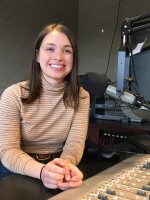Members of the Summit County and Park City Councils received an annual update from the Utah Department of Transportation Monday, outlining the projects planned for Summit County roadways in 2019. The conversation turned from re-paving roads to making Summit County more bikeable.
UDOT plans to spend $23.3 million on road projects in Summit County this year—but Park City Councilmember Steve Joyce commented to UDOT officials that that allocation of funding doesn’t exactly reflect Summit County and Park City’s vision for transportation in and between communities. Councilmember Lynn Ware Peek was also at the meeting, and she says conversations at the city are moving away from the single-passenger car experience to active transportation.
“What we want to do is add to the structure that's in place for the automobile," Peek said. "Let it be as easy, as safe, as well designed for active transportation, whether it's biking, walking, pushing a stroller—oh, I don't know, rollerblading.”
Brad Palmer, UDOT program manager for Summit, Tooele and Salt Lake Counties, says the agency is always thinking about active transportation and how it fits into a project. But there are certain roads where it makes sense to have active transportation and others where it doesn’t.
“A high-speed road such as 224, we probably don't want a lot of bike riders right next to that 45, 50, 55-mile-an-hour traffic," Palmer said. "But an off-road facility like you've got up there on 224, on those shared-use paths—those are really good facilities to do.”
Palmer says funding for active transportation depends on specific projects. Ideally, when there is money available for active transportation, Palmer says UDOT tries to work the concept into the project’s planning stage. In the past couple years, UDOT has worked closely with the Park City Transportation Department on providing more bike lanes in the city, like on Deer Valley Drive.
“The city has a high priority to get that road re-striped, so we're not going to widen it, but we're going to re-stripe the road to fit in some bike lanes," Palmer said. "Also, on 248 from Park City going out to U.S. 40, we’re in the middle of an environmental document right now, and part of that concept in the environmental document is looking at how do we get bike lanes into this project.”
Park City announced a goal of reducing traffic on its major corridors by 25% by the year 2030, with public and active transportation playing a part in that. Peek noted that at the State of the City address in February, residents advocated for safer road biking conditions.
"The more connections we can make, the more that pedestrians, cyclists and e-cyclists feel safe at busy intersections, like on Kearns and Bonanza Drive," Peek says, "the better we can make it, the more people are going to hop on those and the more we're going to forward the community goals of reducing traffic."
Even though UDOT’s primary focus is on cars—because that’s how most people travel—Palmer says if funding isn’t specifically designated for maintenance projects, UDOT gives consideration to all modes of transportation.


